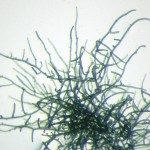Lien vers Pubmed [PMID] – 25980449
Environ. Microbiol. 2016 Feb;18(2):384-400
The cyanobacteria Microcystis proliferate in freshwater ecosystems and produce bioactive compounds including the harmful toxins microcystins (MC). These secondary metabolites play an important role in shaping community composition through biotic interactions although their role and mode of regulation are poorly understood. As natural cyanobacterial populations include producing and non-producing strains, we tested if the production of a range of peptides by coexisting cells could be regulated through intraspecific interactions. With an innovative co-culturing chamber together with advanced mass spectrometry (MS) techniques, we monitored the growth and compared the metabolic profiles of a MC-producing as well as two non-MC-producing Microcystis strains under mono- and co-culture conditions. In monocultures, these strains grew comparably; however, the non-MC-producing mutant produced higher concentrations of cyanopeptolins, aerucyclamides and aeruginosins than the wild type. Physiological responses to co-culturing were reflected in a quantitative change in the production of the major peptides. Using a MS/MS-based molecular networking approach, we identified new analogues of known classes of peptides as well as new compounds. This work provides new insights into the factors that regulate the production of MC and other secondary metabolites in cyanobacteria, and suggests interchangeable or complementary functions allowing bloom-forming cyanobacteria to efficiently colonize and dominate in fluctuating aquatic environments.


